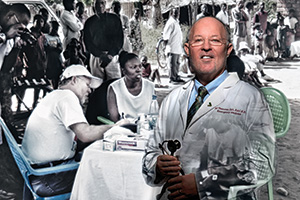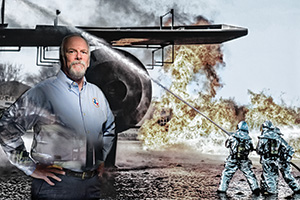Learn more

Emergency room physician Martin "Ed" Thornton ('77) unloaded patients arriving in helicopters at Louis Armstrong New Orleans International Airport as flooded hospitals evacuated people after Hurricane Katrina in 2005. The then-50-year-old doctor carried patients over his shoulder to the makeshift triage center within the un-air-conditioned airport. There, he faced one of the most challenging situations he had ever seen.
Thornton and his colleagues had been deployed to offer medical help as part of the Texas Disaster Medical Assistance Team for Region 4 -- a Dallas-based team of medical professionals activated during disasters. He and fellow rescuers had to figure out how to treat thousands of patients without the medical supplies needed to keep some alive.
"There wasn't time to be depressed, but I saw some things there that people should never see," he says. "It was a first-world city that was turned into a third-world city overnight."
Alumni such as Thornton are making a difference in difficult emergency situations around the world through careers in medicine, emergency management and more. Whether those emergencies are related to tornadoes, hurricanes and other destructive weather or are of human origin -- such as industrial accidents, terrorist acts or war -- alumni are reaching out to help prevent or prepare for them, recover and rebuild.
UNT has earned a reputation as a leader in emergency management and has been building on that foundation since 1983 when offering the nation's first undergraduate emergency administration and planning program. And numerous faculty research and expertise extend the program's relevancy around the world. Take Sudha Arlikatti, associate professor and emergency administration and planning program coordinator, who recently studied flash flood response strategies in India after thousands of people died in last June's flooding in Uttarakhand in the Himalayan foothills, and Gary Webb ('92, '94 M.S.), associate professor and interim chair of UNT's Department of Public Administration, regularly teaches a fire and emergency management course at the Korean National Fire Service Academy in South Korea. And David McEntire, professor and member of the Federal Emergency Management Agency (FEMA) advisory council and recipient of the Dr. B. Wayne Blanchard Award for Academic Excellence in Emergency Management Higher Education, has conducted extensive research on community preparedness and homeland security.
In addition to a bachelor's degree, students can earn an academic certificate in volunteer and community resource management, the first of its kind. And they gain hands-on experience learning how to handle emergencies in UNT's state-of-the-art Emergency Operations Center, a learning lab, giving them an opportunity to put critical thinking skills into action.
"UNT isn't just the nation's first program, we also are a leader in the disaster profession," McEntire says. Through a solid foundation in emergency management theory and valuable practical experience and connections, UNT's program is the model academic degree program in the U.S. and around the world."
Thornton's interest in medicine began early. At 2 or 3 years old, Thornton "operated" on a stuffed toy, sewing up a toy kitten with a needle that his mother gave him while using a cone-shaped lamp from his granddad as an "X-ray machine."
He earned a bachelor's degree in chemistry and biology from UNT and learned from English faculty member Jerry Vann that he must always give people his best effort -- he remembers that today when he's treating patients.
After earning a Doctor of Osteopathic Medicine degree from the UNT Health Science Center, Thornton embarked on a career in emergency medicine. His interest in disaster medicine began after the Sept. 11 terrorist attacks, when he sat on an airport tarmac waiting for someone to take him to New York City to offer medical help.
"And it turned out there really weren't people to treat," he says. "I remember the feeling that I wanted to be available after disasters for my country and even in the world," says Thornton, now an emergency medical physician at Baylor Emerus Emergency Services in Aubrey. "I knew that it would never happen going by myself into disaster zones. You can do that, but it is really hard because you don't fit into anyone's system."
After that, Thornton began his involvement in the Texas Disaster Medical Assistance Team for Region 4, for which he serves as chief medical officer, and has become an expert in disaster education and planning. Thornton also is chair of the American Academy of Disaster Medicine and has traveled to countries such as Guatemala, Haiti, Malawi and Tanzania to offer medical assistance. Closer to home, he has offered help after hurricanes Ike and Rita in addition to Katrina, and has spoken across the country, including at the 2007 World Hazmat Expo.
When Thornton arrived in Haiti to offer help after the 2010 earthquake, he found that about half of the 300 people in one of the rescue camps were sick with nausea, vomiting and diarrhea. He cleaned the water with bleach and iodine tablets, and within three days, everyone in the camp was well.
Disasters are in some ways "the ultimate emergency room," he says. "You may have few or little supplies and have to come up with things that don't exist."

David McCurdy ('89, '01 M.P.A.), now manager of the Office of Emergency Management at Dallas/Fort Worth International Airport, developed a taste for adventure as an 18-year-old chasing tornadoes in Mineral Wells.
He earned an associate's degree in nursing and bachelor's degree in criminal justice and came to UNT for a second bachelor's degree -- this time in emergency management and planning -- while working as a Grapevine police officer. He returned to UNT for a Master of Public Administration degree, learning from such quality faculty members as Robert Bland and Charldean Newell.
Decades ago, the fire chief or a public works employee handled emergency management, says McCurdy. But as issues became more complicated, people needed more training -- and UNT filled that need. The profession has become more sophisticated over the years, he says. In the early days, setting up an emergency operations center meant getting a box of phones and supplies, setting up tables and plugging in the phones -- which could take 30 to 45 minutes. By that time, the emergency could be over, McCurdy says.
"Now we have a state-of-the-art type facility and everything is already in place," he says. "It has evolved from getting stuff out of the closet to now just turning on the lights, and we are in business."
McCurdy joined DFW Airport in 1991 and worked as a first responder in various roles, including paramedic, EMS training officer and battalion chief in the fire/rescue division. He has worked at the airport through such emergencies as hurricanes Rita, Katrina, Ike and Gustav and during wildland fire outbreaks. He also participated in the airport's emergency management operations during the 2011 ice storm that brought the North Texas region to a near-standstill -- just as it was hosting the Super Bowl -- and more recently managed emergency operations during the night shift at the airport in December's ice storm.
Under his supervision, the airport emergency management team also offers training exercises around the region, state and country, often in cooperation with the state of Texas or the Federal Emergency Management Agency.
Through his career, McCurdy also has worked as a registered nurse in emergency departments. Although he doesn't practice nursing today, he uses the knowledge in emergency operations.
"It gives me a holistic view of the community, not only from a fire and police perspective -- where we squirt water on a fire or get people out of a flood zone -- but also from the perspective of the hospitals and health care system, which play a big role in emergencies," he says.

Kent Baxter ('88), management analyst in the Office of the Regional Administrator at FEMA Region 6 in Denton, began working for the agency after graduating from UNT's emergency administration and planning program.
Spanning a 23-year career, he has worked with local communities to ensure they were prepared for hazardous material emergencies, evaluated nuclear power plant exercises and drills and helped with the national flood insurance program. And he served as hurricane program manager in the early '90s and again in the late 2000s.
Through those years, Region 6 has endured the Oklahoma City bombing, the space shuttle Columbia crash and several hurricanes, among others.
Although the agency had dealt with other hurricanes, Katrina was a disaster of an unprecedented scale, he says.
"There was nothing like Katrina where you pretty much had a whole city where everyone had left and nobody could return after the hurricane," he says. "People had driven hundreds of miles away. Everyone went everywhere. It was a difficult time."
At that time, he was senior mitigation specialist, traveling into the communities and talking to local government officials about developing plans to distribute assistance and help the area recover.
Baxter says that although weather events can't be prevented, FEMA and other emergency management agencies do their best to lessen the impact of disasters -- by making a home more fire resistant in mountain regions, he says, or elevating houses in floodplains.
"What you can't mitigate, or what is too costly to mitigate, you prepare for," Baxter says. "Then when an event occurs, you go into recovery. You start rebuilding. And you want to build back stronger."

While in the Coast Guard, Juan Ortiz ('94) helped evacuate people from Brazoria County in South Texas after a flood. Then studying at UNT, he realized his Coast Guard experience fit well with emergency management.
"I realized I was in the right place and this was the program for me," Ortiz says. "The staff at UNT really made me feel at home and showed how they could work with me to help me get my degree and make the right connections."
They helped him secure an internship with the city of Fort Worth, where he began his career as an emergency management officer. He worked for Fort Worth for nearly five years -- a period including a 1995 hailstorm that injured people attending the city's Mayfest event. Ortiz responded to the Emergency Operations Center, addressing issues and dealing with damage assessments.
Later, Ortiz moved to Corpus Christi to serve as that city's emergency management coordinator. There, he earned experience preparing for hurricanes, tropical storms and disasters from petrochemical industries and refineries in the area and helped create an emergency operations center for the city.
He handled about five tropical storms and two major hurricanes, including Hurricane Brett that caused the evacuation of Corpus Christi in 1999. Fortunately, the hurricane headed south of the city to a less heavily populated area. But the lessons learned from the evacuation led to a statewide committee that improved hurricane planning.
After returning to the city of Fort Worth in 2003, Ortiz, as the emergency management coordinator oversaw the development of a modernized 28,000-square-foot center in the city that also could be used by the county and the local Texas Disaster District during emergencies. And his leadership during the 2011 Super Bowl winter storm -- which encased the area in ice and led to water main breaks and rolling blackouts -- improved coordination of efforts.
"We are not the police officers, we are not the fire fighters, but we are the folks behind the scene responsible for making sure everything works well," Ortiz says. "And if something doesn't work well, we figure out what happened and what went wrong, and we learn from those mistakes."
He credits UNT's emergency administration and planning program with preparing him.
"I know other academic programs in emergency management like this program is popping up in other parts of the country," Ortiz says, "but still today UNT is the leader."

While working at a bookstore during her college studies, Molly Thoerner ('02, '05 M.P.A.) flipped through an emergency management textbook -- and realized she could have a career dealing with tornadoes and terrorism.
Within weeks, she switched her major, eventually earning a bachelor's degree in emergency management from UNT.
"The topics that I learned about were very different -- from hazardous materials to tornadoes to planning to social services to recovery. It appealed to my nature to serve the community and be a part of something bigger," she says.
Faculty members' experience and accessibility created a supportive learning environment for her, she says, and she gained hands-on experience at an internship at Southwest Airlines, working on disaster recovery plans for plane crashes.
In 2002, Thoerner began working for the North Central Texas Council of Governments, a voluntary association of local governments. She rose to her current position as director of emergency preparedness. She helps with emergency management planning and homeland security grant administration for the region, which includes 234 municipalities in a 16-county area, equivalent to the state of Maryland in population and mileage.
Thoerner's job often involves preparing for the unthinkable -- and trying to prevent it.
What if a major tornado swept through the DFW area? How could residents get enough warning to take cover? The council was one of several organizations that helped work toward the installation of state-of-the-art weather radar equipment, called CASA, at UNT's Discovery Park. Installed in 2013, the radar is expected to provide more detailed information about impending bad weather, potentially saving lives.
The council also helped coordinate a major emergency preparedness exercise called Urban Shield that took place in November at about 25 sites with thousands of people participating. Response teams practiced different scenarios -- terrorist attacks, car crashes, plane crashes and mass casualties. They found areas that worked as expected and identified areas they needed to tweak, Thoerner says, making them better prepared for future emergencies.
"UNT has been a catalyst for the level of professionalism in emergency management in the region," she says. "Graduates are outstanding local emergency management coordinators, and they make our region a leader in the state and nation."
Photography by Gary Payne. The montaged portraits of each alum began with submitted art from the subjects related to their field of work, which were projected onto separate images of each subject photographed in the studio on a white background.